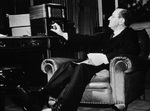Lothian
| Surname | Kerr |
| Given Name | Philip |
| Born | 1882 |
| Died | 12 Dec 1940 |
| Country | United Kingdom |
| Category | Government |
| Gender | Male |
Contributor: C. Peter Chen
ww2dbasePhilip Henry Kerr was born in London, England, Britain as the third son of Lord Ralph Drury Kerr, the 7th Marquess of Lothian. He was educated at the Oratory School and New College, Oxford, England. Between 1905 and 1910, he served in the South African government. In 1916, he was appointed David Lloyd George's private secretary and traveled with George to the Paris Peace Conference after WW1. Between 1921 and 1922, he served as the Director of the United Newspapers. In 1931, he served four months as the Chancellor of the Duchy of Lancaster. Between 1931 and 1932, he was the Under Secretary of State of India.
ww2dbaseAs someone with colonial government experience, Lord Lothian supported the movement for more political weight and more independence for the colonies, although he would only fight for such rights for the white colonial officials, not the natives. The natives, he thought, were to be protected by the Europeans rather than empowered.
ww2dbaseBetween 1939 and 1940, Lord Lothian was the British Ambassador to the United States. Early reactions to Lord Lothian was unfavorable, for that because he was a close political ally to Prime Minister Neville Chamberlain, Americans assumed he would be another arrogant royalty making a tour in Washington, DC while preaching peace must be maintained at any price. The Americans soon changed their minds about him, however. When he visited Franklin Roosevelt the first time, he avoided the stereotypical top hat and striped trousers, and made sure to speak to the journalists after the visit. Journalist William Allen White noted that Lord Lothian looked like "a professor at a teachers college" rather than an aristocrat. Furthermore, he removed "the red-coated, bearskin-hatted, black-booted guardsmen from the embassy entrance." When Winston Churchill became the Prime Minister of Britain in May 1940, Lord Lothian maintained his position as the ambassador. He was instructed to "[d]o nothing to discourage Americans from speculating that if Britain fell, its fleet would fall into the hands of the Germans", which in turn would be used against the United States. He had a tough balancing act, for that if he exaggerated the danger, it would drive the Americans further into their isolationism, but yet he had to convince the United States to enter the war before Britain's own survival was threatened. Throughout 1940, he worked hard with Roosevelt's government in support of the destroyers-for-bases deal, and then helped Roosevelt and Churchill develop the Lend-Lease program.
ww2dbaseLord Lothian worked hard to made sure United States would help Britain survive the war, but the stress brought him to the sickbed in Dec 1940. A devoted Christian Scientist, he refused medical help, and continued to work on a speech meant to be delivered to the American Farm Bureau Federation. On 12 Dec 1940, five days after he initially fell ill, he passed away. The autopsy showed that he died of uremic poisoning. He was buried in the Arlington National Cemetery in Arlington, Virginia, United States.
ww2dbaseSources: Washington Goes to War, Wikipedia.
Last Major Revision: Oct 2007
Photographs
 |  |
Lothian Timeline
| 1 Jan 1882 | Philip Kerr was born. |
| 12 Dec 1940 | Philip Kerr passed away. |
Please consider supporting us on Patreon. Even $1 per month will go a long way! Thank you. Please help us spread the word: Stay updated with WW2DB: |
Visitor Submitted Comments
All visitor submitted comments are opinions of those making the submissions and do not reflect views of WW2DB.

» Destroyers for Bases Agreement
Related Books:
» Washington Goes to War
- » 1,182 biographies
- » 337 events
- » 45,132 timeline entries
- » 1,249 ships
- » 350 aircraft models
- » 207 vehicle models
- » 376 weapon models
- » 123 historical documents
- » 261 facilities
- » 470 book reviews
- » 28,430 photos
- » 365 maps
Thomas Dodd, late 1945
10 Jan 2025 10:21:47 AM
I found this extremely interesting and it poses the question:
`Why is more not known of this great man`s contribution to the saving of the FREE world via his efforts, which eventually led to his death because of the stress inflicted on him due to his duty?`